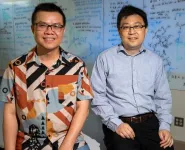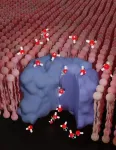(Press-News.org) Every protein in your body is made up of the same 20 building blocks called amino acids. But just because nature is stuck with a limited toolkit doesn’t mean humans can’t expand it.
A study published in Science on July 27 by a team including Pitt chemists describes a powerful new way to create “unnatural” amino acids, which could find use in protein-based therapies and open up novel branches of organic chemistry.
“This is a completely new transformation: new to nature and new to chemistry,” said Peng Liu, a professor of chemistry in the Kenneth P. Dietrich School of Arts and Sciences and a corresponding author on the paper. “Telling an enzyme to create an unnatural configuration of an amino acid is unusual, and you have to do it with careful bioengineering.”
Change just one piece of a larger protein, and you can alter how it’s shaped and what it does — so unnatural amino acids hold promise for opening up new kinds of therapies like antibiotics or immunosuppressants that make use of proteins or their smaller cousins.
Creating such molecules in the lab, however, is an onerous, multistep process: The pieces of the amino acid that link to one another to form a protein chain have to be protected as researchers chemically transform the rest of the molecule. The reaction described in the new paper, however, is simpler and more efficient, and it offers chemists an unprecedented level of control over how groups of atoms are oriented in the resulting molecule.
It also employs a chemical tool, a PLP enzyme, in an unusual way. Enzymes are proteins that catalyze reactions — typically, even when their functions are altered by bioengineering, all they can do is speed up known chemical processes that chemists could achieve in other, albeit slower ways. But paired with a light-sensitive molecular catalyst, the enzyme in this new reaction can achieve far more than that.
“You can argue that bioengineered enzymes provide better efficiency than small molecule catalysts, but they catalyze the same reaction,” said Liu, pictured right. “But this is an entirely new reaction. It simply didn’t exist before.”
Liu’s group uses computer simulations to figure out the intricate dance that happens in a chemical reaction on the level of atoms and electrons, adding the “why” to the “what” discovered by groups that conduct experiments. For this paper, Liu and Pitt postdoctoral researcher Binh Khanh Mai, pictured left, worked with a team of researchers at UC Santa Barbara led by Yang Yang — a collaboration that’s been going strong since 2014, when Yang spent a summer in Liu’s lab as a visiting graduate student.
Liu and Mai dove into the data provided by Yang’s group to understand how and why the reaction took place, puzzling out the intermediate steps that are invisible to chemists. In one step the duo took a particularly close look at, an electron has to travel an unusually long distance on its path between two molecules. “We had to do some careful modeling about the likelihood of this because this is the step that’s new to nature, and it supports the entire reaction mechanism,” Liu said.
Underpinning those models is tremendous computing power. Liu cites Pitt’s Center for Research Computing as an essential ingredient in the lab’s success, as the complex simulations the group performs to understand the intricacies of chemical reactions requires time with cutting-edge, powerful supercomputers.
Even so, there are questions still unanswered, and this paper is just the first step in a series of collaborations between the two teams. If they can better understand why the unusual reaction happens, Liu’s group may open up the ability to harness it in different contexts to create a wide variety of new chemical tools, medicines and more.
“You can think about how many different types of unnatural amino acids you could make — there are an almost unlimited number,” Liu said. “So can we use this insight to develop other new reactions, too?”
— Patrick Monahan, photography by Tom Altany
END
New chemical process makes it easier to craft amino acids that don’t exist in nature
2023-07-31
ELSE PRESS RELEASES FROM THIS DATE:
Social media marketing most effective when it prompts consumers to start posting
2023-07-31
Social media is a critical marketing tool to help raise awareness when firms launch new products. The platforms can help inform consumers about product characteristics and benefits relative to competitors’ products.
New research from the University of Notre Dame analyzes data from the motion picture industry, which often relies on social media promotion, in an effort to understand how marketers could better promote other new products.
“The Ripple Effect of Firm-Generated Content on New Movie Releases,” forthcoming in the Journal of Marketing Research ...
Study shows new stroke surgery eligibility criteria may dramatically increase lifesaving stroke surgery rates, with nationwide implications
2023-07-31
Study Shows New Stroke Surgery Eligibility Criteria May Dramatically Increase Lifesaving Stroke Surgery Rates, with Nationwide Implications
SAN DIEGO—A recent study presented today at the Society of NeuroInterventional Surgery’s (SNIS) 20th Annual Meeting noted that U.S. rates of endovascular thrombectomy, a lifesaving stroke treatment, are projected to increase dramatically based on new criteria.
In the study, endovascular thrombectomy was shown to improve clinical outcomes in patients with large ischemic strokes. This change has the ...
Lignin separation method could make renewable material profitable
2023-07-31
RICHLAND, Wash. – A novel method to extract lignin could help spin wheat straw into gold. Lignin produced using the new method was color-neutral, odorless and homogenous, an advance that could make this carbon-neutral material a more viable candidate for development of high-value products.
Reporting in the Proceedings of the National Academy of Sciences, the Washington State University researchers extracted up to 93% lignin with up to 98% purity from wheat straw, producing a significant amount of material in a uniform way that could make ...
Hydrogen sulfide shows promise as healthy ageing therapeutic when specifically targeted within cells
2023-07-31
Future therapies to help people live healthy lives for longer could be developed from drugs that release tiny amounts of the gas hydrogen sulfide (H2S), new research has indicated.
A study from the University of Exeter, funded by the US Army and charity The United Mitochondrial Disease Foundation, found that targeting tiny amounts of H2S to specific areas of cells in adult worms using a H2S-releasing molecule called AP39, greatly improved health and activity as they aged. The research, published in PNAS, concludes that targeting ...
MIT engineers create an energy-storing supercapacitor from ancient materials
2023-07-31
CAMBRIDGE, Mass. -- Two of humanity's most ubiquitous historical materials, cement and carbon black (which resembles very fine charcoal), may form the basis for a novel, low-cost energy storage system, according to a new study. The technology could facilitate the use of renewable energy sources such as solar, wind, and tidal power by allowing energy networks to remain stable despite fluctuations in renewable energy supply.
The two materials, the researchers found, can be combined with water to make a supercapacitor — an alternative to batteries — ...
How flies develop sight: Scientists use single-cell sequencing to identify cell types in the visual system
2023-07-31
New York University researchers have discovered new cell types in the visual system of flies, made possible by their creation of a tool that finds and labels neurons during development.
The study, published in the journal Proceedings of the National Academy of Sciences (PNAS), combines single-cell sequencing data with a novel algorithm to identify pairs of genes that point to previously unknown cells in the brains of fruit flies.
Fruit flies (also known as Drosophila) have long been used as a model organism to study fundamental ...
Study reveals long-debated makeup of the molecules that help organize your cells
2023-07-31
For years, we’ve known that a special kind of molecular assembly known as a “polyelectrolyte complex” helps your cells keep themselves organized. These complexes are very good at forming interfaces to keep two liquids separated: your cells use them to create compartments. These abilities have led scientists to consider them for technological applications, including filtering water, better batteries, and even underwater glue, as well as for better pharmaceutical drugs.
But for decades, no one knew exactly ...
How to distinguish slow and fast earthquakes
2023-07-31
Researchers from the University of Tokyo and Stanford University show what differentiates slow and fast earthquakes and how their magnitudes vary with time.
Normally, earthquakes last up to a few minutes and radiate strong seismic waves. But around 23 years ago, scientists discovered an unusual slow-slip phenomena called slow earthquakes. Slow earthquakes last days or even months. Though they involve significant tectonic movement, you may never feel them. Since slow earthquakes could indicate future fast earthquakes, monitoring and ...
Research shows filter tip stent retrievers may allow neurointerventionalists to remove blood clots on the first try during stroke treatment
2023-07-31
FOR IMMEDIATE RELEASE: July 31, 2023, 12:00 P.M. PDT
CONTACT: Camille Jewell
cjewell@vancomm.com or 202-248-5460
Research Shows Filter Tip Stent Retrievers May Allow Neurointerventionalists to Remove Blood Clots on the First Try During Stroke Treatment
SAN DIEGO—Research presented today at the Society of NeuroInterventional Surgery’s (SNIS) 20th Annual Meeting shows that different types of stent retriever tips may result in improved patient outcomes when performing mechanical thrombectomy to treat stroke.
Ischemic stroke, one of the most common types of strokes, happens ...
Nuclear spin's impact on biological processes uncovered
2023-07-31
A research team led by Prof. Yossi Paltiel at the Hebrew University of Jerusalem with groups from HUJI, Weizmann and IST Austria new study reveals the influence of nuclear spin on biological processes. This discovery challenges long-held assumptions and opens up exciting possibilities for advancements in biotechnology and quantum biology.
Scientists have long believed that nuclear spin had no impact on biological processes. However, recent research has shown that certain isotopes behave differently due to their nuclear spin. The team focused on stable oxygen isotopes (16O, 17O, 18O) and found ...




